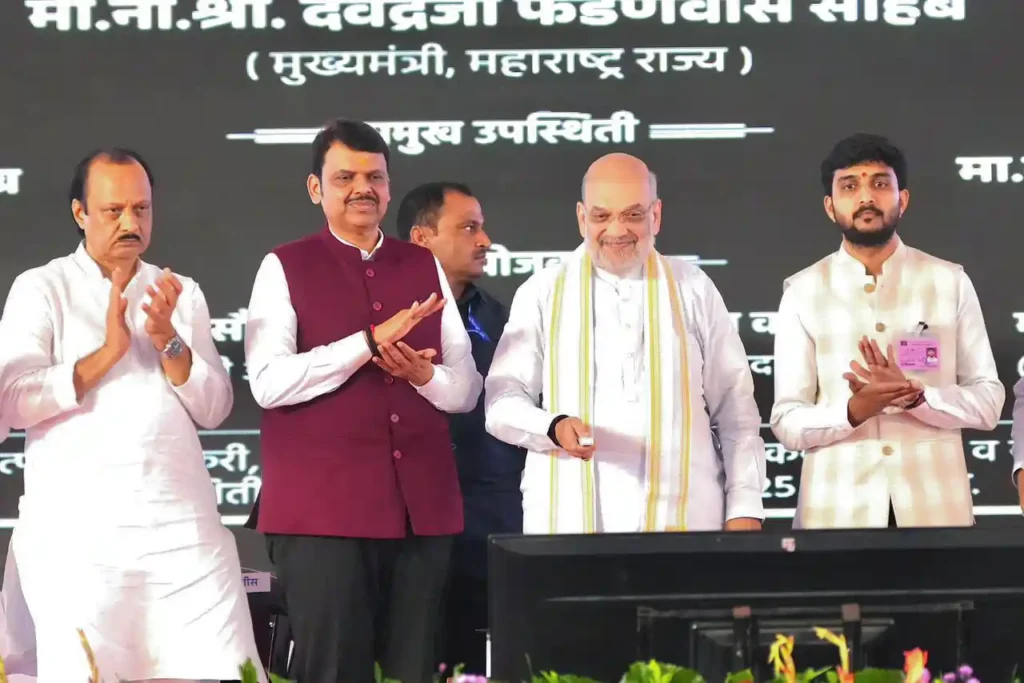New Delhi: On October 5, 2025, India marked a historic milestone with the inauguration of its first cooperative multi-feed compressed biogas (CBG) plant at Maharshi Shankarrao Kolhe Sahakari Sakhar Karkhana in Kopargaon, Ahilyanagar district, Maharashtra. Developed with support from the National Cooperative Development Corporation (NCDC), this pioneering facility is set to produce 12 tons of CBG daily and 75 tons of potash from jaggery, molasses, and other inputs. This initiative reduces India’s reliance on imported CBG and potash, advancing the nation’s journey toward self-reliance in energy and agriculture.
The inauguration was led by Union Home Minister and Minister of Cooperation, Shri Amit Shah, in the presence of Maharashtra Chief Minister Shri Devendra Fadnavis, Deputy Chief Ministers Shri Eknath Shinde and Shri Ajit Pawar, and Union Minister of State for Cooperation Shri Murlidhar Mohol, among other dignitaries. This event underscores a collaborative push by central and state governments to promote sustainable practices in rural economies.

The Role of NCDC in Cooperative Development
Founded in 1963 as a statutory organization under the Ministry of Cooperation, the NCDC is dedicated to fostering farmer cooperatives across India. Its support for this project highlights its commitment to agricultural innovation. For the first time in the history of India’s cooperative sugar mills, a CBG plant paired with a potash granule production unit has been established. Shri Amit Shah announced that the Modi government will extend full support to 15 selected sugar mills nationwide, enabling them to set up similar facilities with NCDC assistance. This initiative is poised to transform sugar mills across the country, setting a new benchmark for cooperative enterprises.
Shri Shah emphasized that cooperative sugar factories originated in Maharashtra, and the state is now leading the charge toward a 100 percent circular economy for these factories. The Maharshi Shankarrao Kolhe Sahakari Sakhar Karkhana serves as an exemplary model, repurposing waste into valuable resources to minimize environmental impact while maximizing economic benefits.
Understanding Compressed Biogas: Production and Process
Compressed biogas (CBG) is a clean, renewable fuel comparable to compressed natural gas (CNG). It is derived from raw biogas produced through anaerobic digestion of biomass and waste materials, such as agricultural residues, cattle dung, and food waste. Raw biogas typically comprises 55–60 percent methane (CH₄), 35–40 percent carbon dioxide (CO₂), and impurities like hydrogen sulfide (H₂S) and water vapor.
To produce CBG, raw biogas undergoes purification to remove H₂S, CO₂, and water vapor, increasing the methane concentration to over 90 percent. The purified gas is then compressed to 200–250 bar, resulting in high-quality CBG suitable for transportation and other applications. The Kopargaon plant’s multi-feed design enables it to process diverse inputs like jaggery and molasses, enhancing its efficiency and versatility.
Backed by an investment of approximately Rs. 55 crore, the plant will generate 12 tons of CBG and 75 tons of potash daily, directly addressing India’s import dependency for these resources and fostering greater self-sufficiency.
Significance of CBG for India’s Energy and Environment
The CBG plant offers profound benefits for India’s energy security and environmental sustainability. By reducing the need for imported natural gas and crude oil, it conserves foreign exchange reserves and strengthens national energy independence. Environmentally, CBG lowers pollution and carbon emissions, aligning with India’s Panchamrit commitments to combat climate change.
Additionally, CBG supports effective waste management, contributing to the Swachh Bharat Mission’s objectives of cleanliness and sanitation. For rural communities, it creates additional income streams for farmers through the sale of biomass and waste, while generating employment opportunities in plant operations and related activities. This holistic approach revitalizes rural economies and promotes sustainable agricultural practices.
Government Initiatives to Promote CBG
India’s policy framework has been instrumental in advancing CBG adoption. The National Policy on Bio-Fuels 2018 emphasizes the promotion of advanced biofuels, including CBG. The Galvanizing Organic Bio-Agro Resources Dhan (GOBAR-DHAN) scheme focuses on converting cattle dung and farm solid waste into bio-CNG (CBG) and compost. The Sustainable Alternative Towards Affordable Transportation (SATAT) initiative encourages the establishment of dedicated CBG production plants, fostering private and cooperative investments.
Shri Amit Shah urged sugar mills to diversify into fruit processing to stimulate fruit cultivation and enhance profitability. He noted that the first sugarcane-based ethanol plant was established at this location, reinforcing its innovative legacy. He also called on the Maharashtra government to collaborate closely, assuring full support from the central government to replicate this model across all sugar mills in the state for future operational benefits.
Agricultural Reforms Under the Modi Government
The CBG plant’s launch aligns with several farmer-centric reforms under Prime Minister Shri Narendra Modi’s leadership. Shri Shah highlighted the ‘Mission for Aatmanirbharta in Pulses’, launched on October 1, 2025, with an allocation of Rs. 11,440 crore over six years to achieve self-reliance in pulses production. The mission includes establishing 1,000 processing units and distributing 88 lakh high-quality seed kits, with operational plans specifying 38 lakh kits for targeted implementation.
Farmers growing arhar, urad, and masoor pulses can register with NAFED and NCCF to sell their entire crop at the minimum support price (MSP), benefiting approximately 20 million farmers, including those in Maharashtra. This ensures 100 percent MSP procurement, providing economic stability.
Recent cabinet decisions have increased MSP rates: Rs. 300 per quintal for masoor, Rs. 250 for mustard, Rs. 225 for gram, Rs. 175 for barley, and Rs. 160 for wheat. Over the past 11 years, MSPs have risen significantly—jowar and bajra by two and a half times, tur (arhar) and moong by 100 percent, and soybean and cotton by twofold.
GST rates have been reduced to 5 percent on essential agricultural items, including tractors, tractor parts, harvesters, threshers, sprinklers, drip irrigation systems, and machinery for poultry and beekeeping. Organic pesticides and natural menthol also benefit from this reduction, easing financial burdens for millions of farmers.
Community Empowerment and Cooperative Revival
The Sanjeevani Group, associated with the Karkhana, has spearheaded initiatives in green energy and sustainability, empowering women’s self-help groups, integrating 100 Primary Agricultural Credit Societies (PACS), initiating fisheries projects for 1,000 farmers, and establishing Sanjeevani University for 20,000 students. India’s first rural call center was also set up here, creating significant employment opportunities.
Shri Shah credited the Ministry of Cooperation, established under Modi’s leadership, with revitalizing the rural economy. Over the past three years, uncertainties surrounding the cooperative sector have been resolved, positioning it as a robust pillar of the nation—a source of pride for all Indians.
Embracing Swadeshi and Environmental Stewardship
Shri Shah echoed Prime Minister Modi’s call for citizens and traders to adopt indigenous products, harnessing the purchasing power of 140 crore Indians to boost the economy. Under Modi’s leadership, India’s global economic ranking has improved from 11th to 4th, with the third spot within reach. Achieving the top position requires a steadfast commitment to swadeshi principles.
Modi has also urged every citizen to plant one tree in honor of their mother and another for Mother Earth, a pledge aimed at addressing climate change and global warming in the coming years.
Conclusion
The inauguration of India’s first cooperative multi-feed CBG plant is a transformative step toward a sustainable future. By integrating circular economy principles, supporting farmers, and reducing imports, it exemplifies the potential of cooperative models to drive national progress. As Maharashtra leads the way, this initiative promises enhanced energy security, cleaner environments, and prosperous rural communities across India.
Frequently Asked Questions
1. What is the significance of India’s first cooperative multi-feed compressed biogas (CBG) plant in Maharashtra?
The CBG plant, inaugurated on October 5, 2025, at Maharshi Shankarrao Kolhe Sahakari Sakhar Karkhana in Kopargaon, Ahilyanagar district, Maharashtra, is a landmark achievement in India’s sustainable energy journey. It produces 12 tons of CBG and 75 tons of potash daily from inputs like jaggery and molasses, reducing reliance on imported natural gas and potash. The plant supports energy security, lowers carbon emissions, aligns with India’s Panchamrit climate goals, promotes waste management under the Swachh Bharat Mission, and creates additional income and employment opportunities for rural farmers.
2. How is compressed biogas (CBG) produced at this facility?
CBG is derived from raw biogas, which is generated through anaerobic digestion of biomass and waste materials such as agricultural residues, cattle dung, and food waste. Raw biogas contains 55–60% methane (CH₄), 35–40% carbon dioxide (CO₂), and impurities like hydrogen sulfide (H₂S) and water vapor. At the Kopargaon plant, raw biogas is purified to remove CO₂, H₂S, and water vapor, increasing methane content to over 90%. The purified gas is then compressed to 200–250 bar to produce CBG, a clean and renewable fuel similar to compressed natural gas (CNG).
3. What government initiatives support the development of CBG plants in India?
Several policies and programs promote CBG production in India:
SATAT Initiative: Encourages the establishment of CBG production plants to support sustainable transportation. Additionally, the Modi government has committed to supporting 15 selected sugar mills to set up CBG and potash production units with assistance from the National Cooperative Development Corporation (NCDC).
National Policy on Bio-Fuels 2018: Emphasizes the promotion of advanced biofuels, including CBG.
GOBAR-DHAN Scheme: Converts cattle dung and farm solid waste into bio-CNG (CBG) and compost.
4. How does the CBG plant contribute to India’s agricultural and economic goals?
The plant advances India’s self-reliance by reducing imports of natural gas and potash, conserving foreign exchange reserves. It aligns with the ‘Mission for Aatmanirbharta in Pulses’, launched with Rs. 11,440 crore to achieve self-sufficiency in pulses through 1,000 processing units and 88 lakh seed kits. Farmers benefit from 100% MSP procurement for pulses like arhar, urad, and masoor, alongside increased MSP rates for crops like masoor (Rs. 300/quintal), mustard (Rs. 250/quintal), and wheat (Rs. 160/quintal). Reduced GST to 5% on agricultural equipment and organic pesticides further supports farmers’ financial stability.
5. How does the Maharshi Shankarrao Kolhe Sahakari Sakhar Karkhana exemplify a circular economy?
The Karkhana is a model of a circular economy by repurposing waste materials like jaggery and molasses into valuable CBG and potash, minimizing environmental impact while generating economic benefits. It integrates diverse initiatives, including fruit processing to boost profitability, women’s self-help groups, 100 Primary Agricultural Credit Societies (PACS), fisheries for 1,000 farmers, and Sanjeevani University for 20,000 students. The establishment of India’s first rural call center at the site further enhances rural employment, showcasing a sustainable and inclusive economic model.

